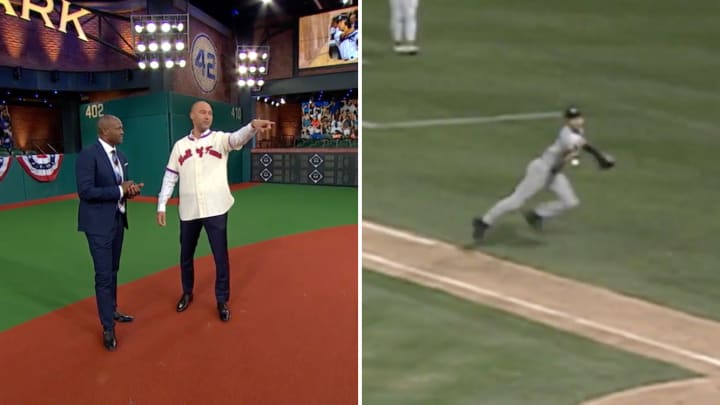Derek Jeter Breaks Down Iconic ‘Flip Play’ in Striking Detail

In Derek Jeter’s Hall of Fame career, there are two defensive plays that stand out as undoubtedly the most memorable: his October 2001 flip from the first base line to preserve a 1–0 Yankees lead in a playoff elimination game and his July 2004 dive into the stands in the 12th inning of a game against the Red Sox.
The 2004 play is the one that sticks out more in my memory (probably because I was old enough to stay up and watch it live, unlike 2001) but the “flip play” is inarguably the most famous defensive moment of Jeter’s career. It had nothing to do with his range and reflexes, which have been denigrated in recent years as advanced statistics begin to paint a clearer picture of his defensive value. Instead, it was evidence of Jeter’s high baseball IQ. He was in an area of the field where you never see a shortstop, and yet he was in the perfect place at the perfect time.
Though the play is included on any highlight reel of Jeter’s storied career, he has not discussed it much in the nearly two decades since it occurred. But when he stopped by the studios of MLB Network on Wednesday, Jeter and analyst Harold Reynolds walked through the play in unprecedented detail.
“We work on this in spring training,” Jeter said, echoing what his teammates have said in the past.
“My job is to watch the runner. The runner at first was Jeremy Giambi. I saw the ball down the line, and my job is to see if there’s going to be a play at third base, right? But once you see that Giambi is going to go home, my job is to turn into the third cutoff man to redirect the throw to third base,” Jeter continued. “Now, we don’t practice actually shuffle-passing the ball to home plate but my job, if you look at the replay, if I actually wanted to throw to third base, we could’ve got Terrence [Long, the batter] at third.”
The decision to flip the ball home instead of turning and trying to get Long at third, Jeter explained, was made because Giambi was not a fast runner.
“I said this before, and I say this very respectfully, the Giambi family is not very fast, so I knew we had an opportunity to get him at the plate,” Jeter cracked.
As for how he was able to get in position to make the play, Jeter said that he knew he would have to back up Tino Martinez and Alfonso Soriano (the two cutoff men on the play) as soon as he saw right fielder Shane Spencer throw the ball. Jeter could tell it was going to go over the heads of Martinez and Soriano.
“If he actually hits one of the first two cutoff men then [Giambi is] out at home plate by about 10 feet,” Jeter said.
One of the few times Jeter has discussed the play was in 2014, during his final trip to Oakland as a player.
“I’ve seen it a lot. I was where I was supposed to be,” Jeter told MLB.com at the time. “I’m not supposed to throw it home, but that’s where I’m supposed to be. I’ve never been one to sit down and sing my own praises. I’m happy it was at a big moment for us. Maybe years from now, but I've just never sat down and looked at it like that.”
